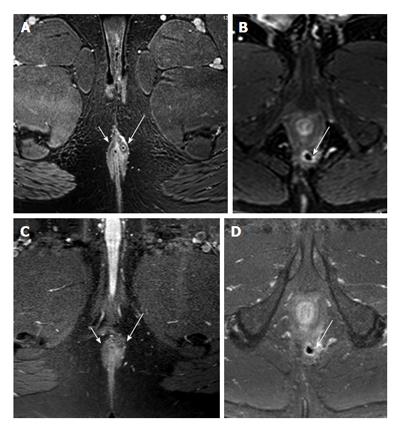Copyright
©2014 Baishideng Publishing Group Inc.
World J Radiol. May 28, 2014; 6(5): 203-209
Published online May 28, 2014. doi: 10.4329/wjr.v6.i5.203
Published online May 28, 2014. doi: 10.4329/wjr.v6.i5.203
Figure 4 Two male subjects, one 39-year old (A and B) and the other 52 years old (C and D), imaged with 3D T1 with fat saturation (A and C) and T1 turbo spin-echo with fat saturation (B and D).
The 39-year-old male (A and B) has an intersphincteric fistula treated with a seton (long white arrows). Both the fistula and seton inside the fistula and luminal part (short arrows) are seen more clearly on 3D images. The 52-year-old has a small intersphincteric abscess cavity (white arrows C and D), which is shown well on both sequences. However the contrast between fat and muscle is poorer on turbo spin-echo compared to 3D T1, making it much easier to correctly appreciate the relationship between fistula/abscess and the surrounding sphincter.
- Citation: Torkzad MR, Ahlström H, Karlbom U. Comparison of different magnetic resonance imaging sequences for assessment of fistula-in-ano. World J Radiol 2014; 6(5): 203-209
- URL: https://www.wjgnet.com/1949-8470/full/v6/i5/203.htm
- DOI: https://dx.doi.org/10.4329/wjr.v6.i5.203









